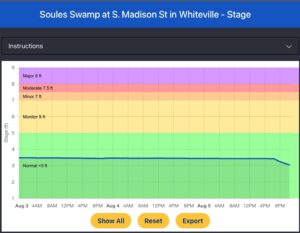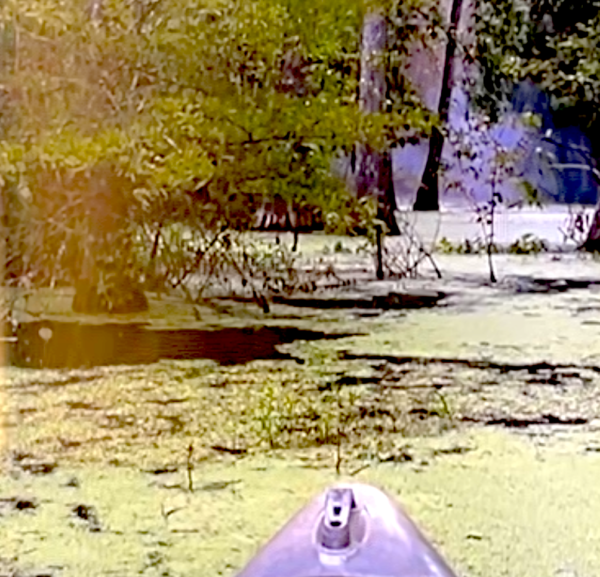Greg Hewitt was watching the forecasts about Hurricane Debby when he decided to do something to help downtown Whiteville.
The owner of Nautilus Elite on Frazier Street has dealt with multiple floods, ranging back to the summer super cell thunderstorm that inundated downtown two months before Hurricane Matthew. He has cleaned up after Hurricane Florence, Tropical Storm Idalia last year, and the heavy rains during December that flooded Frazier Street.
“Who gets flooded at Christmas?” an exasperated Hewitt said.
“It’s ridiculous that the city has tried, but can’t do anything,” he said. He noted that the city has taken on a number of stormwater improvement projects, but very little has been done to attack what many see as at least one major part of the problem: a massive beaver dam downstream of Madison Street bridge.
The dam has been well-known to duckhunters and canoeists for decades. The dam has been in place for so long that the log and mud dam has accumulated soil and debris, creating a long earthen dike estimated by some at a quarter mile in length. Trees and bushes grow on some parts of the dam.
The dam’s location in relation to the city limits, as well as identifying landowners whose property adjoin the dam, has been cited by the city among the reasons larger removal efforts haven’t been undertaken in the past. City crews have breached one portion of the dam before while trying to lower the flood risk, but the beavers immediately patched the hole. Local governments also are encouraged to perform environmental studies on sensitive wetland areas before tackling problems like old, established beaver dams.
The city worked with the USDA to break several dams, including one spot that took three different breaks before it stayed open. Beavers twice repaired the main break on that spot almost overnight before it stayed open. The city removed a large portion of the dam during that attempt.
The dam is only part of a larger problem with aging infrastructure, more impermeable surfaces (like parking lots and roofs) and stormwater runoff systems that were not maintained for years. The city is currently on an aggressive track to improve Mollies Branch to help drainage on the west side, as well as multiple improvement projects downtown and elsewhere.
Whiteville has obtained several million dollars in grants to help improve stormwater runoff and increase flood control in the city. A major buyout program is underway that convert many floodprone properties into greenspace that will absorb stormwater and reduce runoff.
The dam’s somewhat remote location and other factors moved it farther down the city’s priority list.
Private landowners do not face the same hurdles, and Hewitt said he went straight to the source an obtained permission to have the dam professionally demolished.
“If it helps a little, it’s worth the effort,” he said. “If it doesn’t do anything but take some of the water off downtown this time, I think it’s worthwhile.” Hewitt said the city hasn’t been ignoring the issue, but “you need to get to the root of a problem to solve it.”
Doug Smith, an avid kayaker who frequently paddles Soules Swamp, said the dam holds several feet of water even during dry spells. Smith said the natural run of the stream is further blocked by several feet of silt that has built up in the channel.

The silt takes up space that would normally hold additional water – water that ends up backing up into sewers and onto streets in the city. Without a freeflowing channel, mud and silt build up, further slowing the flow of the stream.
“I still think if that dam could be reduced, it would make a world of difference downtown,” Smith said. “It’s going to help the people downstream as well (Smith is a native of Crusoe and Old Dock) because if the water flows on out, there isn’t as much coming down at one time when there’s a big rain event. It can gradually rise, and not overwhelm the Waccamaw River swamps.
As forecasts for Hurricane Debby predicted more and more rainfall, Hewitt decided to take matters into his own hands. He made contact with one of the landowners of the adjacent property, as well as a licensed explosives technician who blows beaver dams for government agencies like the U.S. Dept. of Agriculture APHIS program as well as private individuals. After consultation with local trapper John Deans, Hewett led a team of volunteers to the dam Tuesday.
After the technician carefully set the explosives, the men moved back more than 100 yards. The explosion around 4:30 p.m. was heard throughout downtown.
The water immediately began flowing through a gap around 100 feet long.
“You could look at the water where it was covered in green algae, and it was stagnant, then look at the black water where it was clean,” Hewitt said. “It started flowing immediately.” Video of the explosion shows the men in their kayaks being pulled toward the dam evgen before all the debris had settled from the explosion.
The Flood Information Management Network (FIMAN) gauge on the Madison Street bridge monitors the rise and fall of the stream in real time. The Whiteville FIMAN gauge was installed after Hurricane Florence sent several feet of floodwater above the bridge railings.

Normally, the gauge reads between three and four feet of water over the bed of the channel. Officials begin monitoring conditions when the FIMAN reads five feet at the bridge. At six feet, water is flowing onto the bridge, and Madison Street is closed.
At 4 p.m., the water had been steady at 3.5 feet for several days. The meter showed a drop of a foot within a half-hour of the dam breach Monday. The run continued to fall until around midnight, when it stabilized – at a lower level than it was before the breach.
Hewitt paid to have the dam blown. He said he was glad to do so.
“If we can save a little bit of downtown, it will be worth it,” he said. “I don’t want to be called a hero or anything. This was just something that needed to be done for the community and we got it done.
“The beavers will be back,” he said, “but maybe this will help downtown during this hurricane, anyway.”






